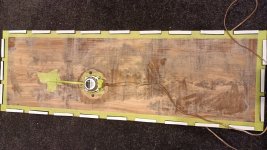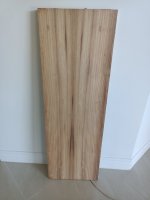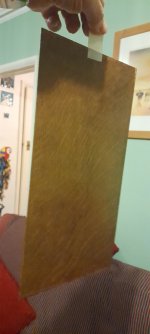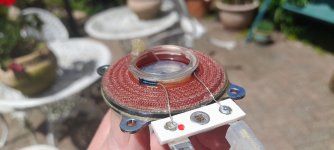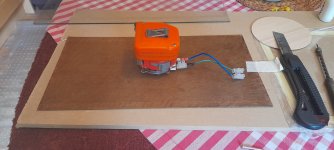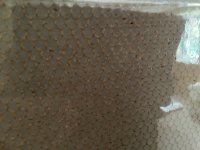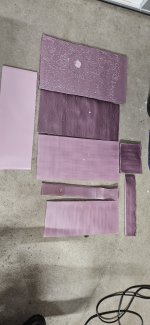So below are the free vs finger held 10mm tap test results
On multiple tests in the same conditions, I find my results to be inconsistent in terms of the resonant peak locations.
Anyway, the absence of spikes in the Blackwood tests does show successful damping.
Both panels seem very dead by feel and when listening to tapping by ear, as distinct from unmounted, but both are very good under normal use.
These Blackwood panels were originally tested a long time ago, and they sounded very good, with very even response, but at 2.5mm thick and 5 ply, were relatively heavy and were hard to drive so I put them aside
Recently, I gained access to a drum sander, so I decided to sand off the rear ply, and thin the front face slightly from each panel. This changed the panels completely, and they are now easy to drive and quite loud. I also routed out a further layer about 120mn or so in diameter centred on the exciter, so that area is about 1.5mn thick.
The resulting 4 ply panel is stiff but flexible if you know what I mean...a bit like a fibre glass panel would feel like, and much different to the poplar I usually use.
I have high hopes for this material. It is recognised as a great tonewood, which is always my main starting point. It's also attractive.
Eucy
On multiple tests in the same conditions, I find my results to be inconsistent in terms of the resonant peak locations.
Anyway, the absence of spikes in the Blackwood tests does show successful damping.
Both panels seem very dead by feel and when listening to tapping by ear, as distinct from unmounted, but both are very good under normal use.
These Blackwood panels were originally tested a long time ago, and they sounded very good, with very even response, but at 2.5mm thick and 5 ply, were relatively heavy and were hard to drive so I put them aside
Recently, I gained access to a drum sander, so I decided to sand off the rear ply, and thin the front face slightly from each panel. This changed the panels completely, and they are now easy to drive and quite loud. I also routed out a further layer about 120mn or so in diameter centred on the exciter, so that area is about 1.5mn thick.
The resulting 4 ply panel is stiff but flexible if you know what I mean...a bit like a fibre glass panel would feel like, and much different to the poplar I usually use.
I have high hopes for this material. It is recognised as a great tonewood, which is always my main starting point. It's also attractive.
Eucy
Attachments
@Eucyblues99 I am a infrequent visitor to this thread, who will one day have a working pair of DML Panel Speakers.
To date I have supplied to the thread a few ideas that have been pondered and also supplied one to the Threads main contributors a Panel Material that has impressed them, to the point there is a want to experiment with the material more in a larger dimension.
Now I have seen your modifying the Blackwood Board Material that has in the past been though of as too heavy and is now produced to weight and flexion thought to be useful. I would like to put forward the suggestion I made in the past for using a Resin Impregnated Densified Wood Board, such as from the Brand Panzerholz or Permali.
These material types are now well known for the exceptional intrinsic Damping and Dissipation Properties the construction produces.
Personally I have heard this material used as a Plinth for a TT and the listening experience of the Material in use in comparison to other Plywood Materials has been notable for the easy to identify improvement in tidying up the end sound.
I have also been introduced to this material as a substitute for other materials where managing energy transferral is of high importance, where the use of Panzerholz has Superseded the earlier in use materials.
Within this Forum to be seen in other Thread Posts, there are Australian Members now moved on to adopt Permali over other materials that have been tried out.
My suggestion for this type of Material is not to produce a DML Panel, but that is an idea not to be ruled out, if a thin enough board could be created?.
The suggestion is to produce a thin disc from Densified Wood to be used to mount the Exciter on as a Interface with the DML Panel.
The intention being the intrinsic properties of Densified Wood, especially in the form of a thin disc may have the influence to improve on the Panels Damping / Dissipation.
As said, after seeing your revisit to a material, I was prompted to revisit the idea suggested for a Resin Impregnated Densified Wood.
To date I have supplied to the thread a few ideas that have been pondered and also supplied one to the Threads main contributors a Panel Material that has impressed them, to the point there is a want to experiment with the material more in a larger dimension.
Now I have seen your modifying the Blackwood Board Material that has in the past been though of as too heavy and is now produced to weight and flexion thought to be useful. I would like to put forward the suggestion I made in the past for using a Resin Impregnated Densified Wood Board, such as from the Brand Panzerholz or Permali.
These material types are now well known for the exceptional intrinsic Damping and Dissipation Properties the construction produces.
Personally I have heard this material used as a Plinth for a TT and the listening experience of the Material in use in comparison to other Plywood Materials has been notable for the easy to identify improvement in tidying up the end sound.
I have also been introduced to this material as a substitute for other materials where managing energy transferral is of high importance, where the use of Panzerholz has Superseded the earlier in use materials.
Within this Forum to be seen in other Thread Posts, there are Australian Members now moved on to adopt Permali over other materials that have been tried out.
My suggestion for this type of Material is not to produce a DML Panel, but that is an idea not to be ruled out, if a thin enough board could be created?.
The suggestion is to produce a thin disc from Densified Wood to be used to mount the Exciter on as a Interface with the DML Panel.
The intention being the intrinsic properties of Densified Wood, especially in the form of a thin disc may have the influence to improve on the Panels Damping / Dissipation.
As said, after seeing your revisit to a material, I was prompted to revisit the idea suggested for a Resin Impregnated Densified Wood.
The Link below shows Permali can be produced from 4mm - 50mm Board Thickness, what is not known is whether Cross Laminate Grain assembly is able to acquired at the thinnest of the produced thicknesses.
https://permalideho.co.uk/what-we-do/
Another Discovery made is the Resin Impregnated Composites Permali are producing starting at a 0.3mm Thickness.
https://www.permali.co.uk/products/...posites/#1671195335082-9b08ce8f-92b87797-bc7a
There is also their product Tuftane which is a film material used in the Formula 1 Motorsport industry, as a very light weight any vibration substance, that can be processed to different harnesses.
https://permalideho.co.uk/what-we-do/
Another Discovery made is the Resin Impregnated Composites Permali are producing starting at a 0.3mm Thickness.
https://www.permali.co.uk/products/...posites/#1671195335082-9b08ce8f-92b87797-bc7a
There is also their product Tuftane which is a film material used in the Formula 1 Motorsport industry, as a very light weight any vibration substance, that can be processed to different harnesses.
The YouTube algorithms started feeding me densified wood videos yesterday, before I read this, and I was thinking the same - if it could be made very thin it might useful as a DML panel.
The permaglass sounds pretty interesting too. There are so many different composites out there but it is too hard for a simple hobbyist like myself to acquire them and test them :|
On the subject of thin composites panels, some time ago I tested a 4-5mm thick XPS panel with epoxy on both sides and it seemed to perform quite well. I cut it up to test smaller sizes and angles far too soon, before I built my test frame, so I never got to do proper comparisons against other panels. I decided to remake it yesterday, and while analyzing the old sample and after initial set of epoxy on this new one, I think I've noticed that this 5mm thick XPS is ringing much less than I expected.
I'm thinking that, maybe, the ~20mm thick panels may actually damp less than this 5mm panel because the layer of XPS is sorta like jello. It jiggles a lot and when it's thick the jiggling all compounds while the damping may stay about the same. Sorta like constrained layer damping - I've heard it said that a thin layer of damping material is better than a thicker layer. There is of course rigidity that comes with greater thickness but I guess I'll find out in a week when I test this panel if 5mm is better than 20mm with epoxy on both sides.
The permaglass sounds pretty interesting too. There are so many different composites out there but it is too hard for a simple hobbyist like myself to acquire them and test them :|
On the subject of thin composites panels, some time ago I tested a 4-5mm thick XPS panel with epoxy on both sides and it seemed to perform quite well. I cut it up to test smaller sizes and angles far too soon, before I built my test frame, so I never got to do proper comparisons against other panels. I decided to remake it yesterday, and while analyzing the old sample and after initial set of epoxy on this new one, I think I've noticed that this 5mm thick XPS is ringing much less than I expected.
I'm thinking that, maybe, the ~20mm thick panels may actually damp less than this 5mm panel because the layer of XPS is sorta like jello. It jiggles a lot and when it's thick the jiggling all compounds while the damping may stay about the same. Sorta like constrained layer damping - I've heard it said that a thin layer of damping material is better than a thicker layer. There is of course rigidity that comes with greater thickness but I guess I'll find out in a week when I test this panel if 5mm is better than 20mm with epoxy on both sides.
Moray.
I was going to use a 50x50 mix of pva on the outside surfaces, but decided to use a neat coating of pva instead.
So the inside and outside is all neat pva.
The panel now weighs 53grm , sorry , but in my haste I forgot to weigh the veneer before applying the glue 🙄
I hung up the panel to finish drying, but was not happy with the flatness.
So , next day, I put the panel out side in the sunshine under the glass again.
After a while, when it was nice and hot , I brought it back inside still under the glass and let it cool down.
It has stayed pretty flat so far, fingers crossed 🤞.
It feels and sounds about right with quite a dead sound, but not too dead I hope.
Next I will glue the exciter to the centre position and see how it sounds.
Hopefully it will not flap around too much in the low frequency department, but it is no problem as I intend to XO at about 200Hz maybe, we shall see.
Steve.
I was going to use a 50x50 mix of pva on the outside surfaces, but decided to use a neat coating of pva instead.
So the inside and outside is all neat pva.
The panel now weighs 53grm , sorry , but in my haste I forgot to weigh the veneer before applying the glue 🙄
I hung up the panel to finish drying, but was not happy with the flatness.
So , next day, I put the panel out side in the sunshine under the glass again.
After a while, when it was nice and hot , I brought it back inside still under the glass and let it cool down.
It has stayed pretty flat so far, fingers crossed 🤞.
It feels and sounds about right with quite a dead sound, but not too dead I hope.
Next I will glue the exciter to the centre position and see how it sounds.
Hopefully it will not flap around too much in the low frequency department, but it is no problem as I intend to XO at about 200Hz maybe, we shall see.
Steve.
Attachments
Sapphiresloth.
Did your 5mm xps have a shiny skin?
How did you apply the epoxy, and how thick was the coating.
I would have preferred a thinner epoxy coating on my 5mm XPS, but still, it produced a good lively sound with a much better frequency response.
Far better than XPS on its own.
Steve.
Did your 5mm xps have a shiny skin?
How did you apply the epoxy, and how thick was the coating.
I would have preferred a thinner epoxy coating on my 5mm XPS, but still, it produced a good lively sound with a much better frequency response.
Far better than XPS on its own.
Steve.
This material is not really much different to Laminex or phenolic circuit board in constructionThe Link below shows Permali can be produced from 4mm - 50mm Board Thickness, what is not known is whether Cross Laminate Grain assembly is able to acquired at the thinnest of the produced thicknesses.
https://permalideho.co.uk/what-we-do/
Another Discovery made is the Resin Impregnated Composites Permali are producing starting at a 0.3mm Thickness.
https://www.permali.co.uk/products/...posites/#1671195335082-9b08ce8f-92b87797-bc7a
There is also their product Tuftane which is a film material used in the Formula 1 Motorsport industry, as a very light weight any vibration substance, that can be processed to different harnesses.
Laminex is layers of phenolic resin impregnated Kraft paper ( ergo wood) heated and compressed at high pressure
Has anyone tried a panel made from Laminex??
All of the XPS I use is sliced from a 2" thick 4'x8' sheet of insulation. After I slice it I then sand it with 220 grit sandpaper. The shiny surface on the outside comes from heat during the manufacturing process and that skin is harder than the interior foam. I've done tons of experiments with intentionally heating the skin of the foam to 'crystalize' it and while it does become very hard and rigid, it also rings quite badly. If it is heated too slowly then it causes sponginess in the layer of foam right under the hardened skin. If one wants to make this 'heat skin' then high heat is needed for a very short amount of time to keep the foam under the hard skin as pristine as possible.
I have done a few attempts of various degrees of 'heat-skin' that is then coated. The hotter and longer you heat the PS the darker and harder it becomes. When heating it shrinks a lot and pulls and warps so it is hard to control. I did not try epoxy coating heat-skins, but I did try PVA, shellac, and hide glue separately. The results were not as good as I hoped and expected them to be. It seems to me that keeping the foam as pristine as possible and then carefully applying coatings yields a better result.
Based on my subjective assessment using hands and ears in the garage I think the foam dampens the best when it has the softest feel. Sanding with 220 grit leaves it very soft and nice feeling and when tapping it you can hear how smooth it sounds. With a shiny or hard skin the impact of fingers on the surface have a more abrasive sound, less 'woosh-ey' and more 'tap-ey'.
I went back out to the garage this afternoon to re-evaluate the ringing and now I am certain that this 5mm XPS with epoxy rings way less than bare 20mm XPS and heavily shellac'd 20mm XPS. It's also a lot more rigid because of the epoxy. For this panel I put 40g of epoxy on one side but it was a little light it seemed, so I put 50g on the other side. Panel is about 53cm x 26cm. I used a 3" wide foam brush to spread the epoxy and that worked really well. I was inspired by the 'tipping' technique I learned about from videos about epoxy coating boat hulls. I've used thinner coatings in the past with thicker XPS, but this time, with the thin panel, I want the epoxy to give a lot of rigidity so there is enough epoxy on it for almost no little 'branches' of foam cells to stick up out of it. It's a pretty smooth and glossy finish. Not sure if this is better than light coating, but it is surely better than thick XPS with light epoxy.
Oh, and this time, on the good side of the panel, I put the cup of mixed epoxy in a hot water bath so it would spread better. The first side I did in garage on ~60F day, but the good side I did inside at about 70F with the warmed epoxy. Because of XPS's sensitivity to heat it isn't a good idea to use a heat gun or torch to get the epoxy to level and the bubbles to come out. I did try a heat gun on the bad side but it was obviously a mistake as a couple spots of XPS reacted to the heat.
I have done a few attempts of various degrees of 'heat-skin' that is then coated. The hotter and longer you heat the PS the darker and harder it becomes. When heating it shrinks a lot and pulls and warps so it is hard to control. I did not try epoxy coating heat-skins, but I did try PVA, shellac, and hide glue separately. The results were not as good as I hoped and expected them to be. It seems to me that keeping the foam as pristine as possible and then carefully applying coatings yields a better result.
Based on my subjective assessment using hands and ears in the garage I think the foam dampens the best when it has the softest feel. Sanding with 220 grit leaves it very soft and nice feeling and when tapping it you can hear how smooth it sounds. With a shiny or hard skin the impact of fingers on the surface have a more abrasive sound, less 'woosh-ey' and more 'tap-ey'.
I went back out to the garage this afternoon to re-evaluate the ringing and now I am certain that this 5mm XPS with epoxy rings way less than bare 20mm XPS and heavily shellac'd 20mm XPS. It's also a lot more rigid because of the epoxy. For this panel I put 40g of epoxy on one side but it was a little light it seemed, so I put 50g on the other side. Panel is about 53cm x 26cm. I used a 3" wide foam brush to spread the epoxy and that worked really well. I was inspired by the 'tipping' technique I learned about from videos about epoxy coating boat hulls. I've used thinner coatings in the past with thicker XPS, but this time, with the thin panel, I want the epoxy to give a lot of rigidity so there is enough epoxy on it for almost no little 'branches' of foam cells to stick up out of it. It's a pretty smooth and glossy finish. Not sure if this is better than light coating, but it is surely better than thick XPS with light epoxy.
Oh, and this time, on the good side of the panel, I put the cup of mixed epoxy in a hot water bath so it would spread better. The first side I did in garage on ~60F day, but the good side I did inside at about 70F with the warmed epoxy. Because of XPS's sensitivity to heat it isn't a good idea to use a heat gun or torch to get the epoxy to level and the bubbles to come out. I did try a heat gun on the bad side but it was obviously a mistake as a couple spots of XPS reacted to the heat.
The investigation of Resin Impregnated Densified Wood, where Phenoilc Resin is the material used to impregnate, has in the past used the other commonly available Phenolic Based Materials as a comparison.
Densified Woods impregnated with a Resin, mist typically a phenolic, even though not all producers refer to this materials, are very very different in their intrinsic Damping / Dissipation measured data.
Densified Wood is very difficult to surpass as a attractive material for D / D properties.
https://www.lessloss.com/docs/20130219/LessLoss_Virtues_PRINT.pdf
Densified Woods impregnated with a Resin, mist typically a phenolic, even though not all producers refer to this materials, are very very different in their intrinsic Damping / Dissipation measured data.
Densified Wood is very difficult to surpass as a attractive material for D / D properties.
https://www.lessloss.com/docs/20130219/LessLoss_Virtues_PRINT.pdf
Sapphiresloth.
The 5mm xps sheets that I used already had the shiny skin surface, pva did very little to help the performance of this panel.
I applied the epoxy directly to this shiny skin.
If I was to sand this skin coating off , the surface would become very soft and absorbant , soaking and absorbing more epoxy.
I used a roller to apply the epoxy, but if I tried this panel again I would try a scrapping method to try and reduce the amount of epoxy.
This would reduce the weight of the panel and hopefully improve the panel efficiency.
Having a more flexible panel also helps to produce a more natural sounding panel, reducing the harshness of rigid panels.
This is one of my old panels, I posted some time ago, with plots and recordings, not sure where.
Epoxy works very well with this panel, it brings the panel alive, and increases the hf to 20k and above.
Pva does not work well for xps, and i would not recommend its use on this material.
i would only recommend pva on EPS.
i blame parts express videos for this misunderstanding.
Steve.
The 5mm xps sheets that I used already had the shiny skin surface, pva did very little to help the performance of this panel.
I applied the epoxy directly to this shiny skin.
If I was to sand this skin coating off , the surface would become very soft and absorbant , soaking and absorbing more epoxy.
I used a roller to apply the epoxy, but if I tried this panel again I would try a scrapping method to try and reduce the amount of epoxy.
This would reduce the weight of the panel and hopefully improve the panel efficiency.
Having a more flexible panel also helps to produce a more natural sounding panel, reducing the harshness of rigid panels.
This is one of my old panels, I posted some time ago, with plots and recordings, not sure where.
Epoxy works very well with this panel, it brings the panel alive, and increases the hf to 20k and above.
Pva does not work well for xps, and i would not recommend its use on this material.
i would only recommend pva on EPS.
i blame parts express videos for this misunderstanding.
Steve.
Attachments
Moray.
It was a lot easier to remove the sticky silicone tape from the panel and exciter, than I thought it would be.
It came off the wood panel very easily, and I just rolled it around the coil foot into a ball of silicone.
I have now glued on the exciter, I will not be using heat to help dry the glue as this will cause the panel to buckle.
I will not be rounding the corners yet, so that we can see what affects this has on the panel, if any 🤔
Although I have an idea of what is going to happen.
As with my other veneer and card panels.
Although this panel is a lot longer than the other veneer panel.
Steve.
It was a lot easier to remove the sticky silicone tape from the panel and exciter, than I thought it would be.
It came off the wood panel very easily, and I just rolled it around the coil foot into a ball of silicone.
I have now glued on the exciter, I will not be using heat to help dry the glue as this will cause the panel to buckle.
I will not be rounding the corners yet, so that we can see what affects this has on the panel, if any 🤔
Although I have an idea of what is going to happen.
As with my other veneer and card panels.
Although this panel is a lot longer than the other veneer panel.
Steve.
Attachments
Oops.
I just noticed that in the close-up photo of the exciter ,that the wires to the coil are glued down to the edge of the spider 🫣
While this is normally OK, it could put the wires a little too close to the spider if playing down into low frequencies.
This could cause some buzzing?
I will keep an eye on it
Steve.
I just noticed that in the close-up photo of the exciter ,that the wires to the coil are glued down to the edge of the spider 🫣
While this is normally OK, it could put the wires a little too close to the spider if playing down into low frequencies.
This could cause some buzzing?
I will keep an eye on it
Steve.
Why not get Nomex honeycomb and fill the cells with epoxyAll of the XPS I use is sliced from a 2" thick 4'x8' sheet of insulation. After I slice it I then sand it with 220 grit sandpaper. The shiny surface on the outside comes from heat during the manufacturing process and that skin is harder than the interior foam. I've done tons of experiments with intentionally heating the skin of the foam to 'crystalize' it and while it does become very hard and rigid, it also rings quite badly. If it is heated too slowly then it causes sponginess in the layer of foam right under the hardened skin. If one wants to make this 'heat skin' then high heat is needed for a very short amount of time to keep the foam under the hard skin as pristine as possible.
I have done a few attempts of various degrees of 'heat-skin' that is then coated. The hotter and longer you heat the PS the darker and harder it becomes. When heating it shrinks a lot and pulls and warps so it is hard to control. I did not try epoxy coating heat-skins, but I did try PVA, shellac, and hide glue separately. The results were not as good as I hoped and expected them to be. It seems to me that keeping the foam as pristine as possible and then carefully applying coatings yields a better result.
Based on my subjective assessment using hands and ears in the garage I think the foam dampens the best when it has the softest feel. Sanding with 220 grit leaves it very soft and nice feeling and when tapping it you can hear how smooth it sounds. With a shiny or hard skin the impact of fingers on the surface have a more abrasive sound, less 'woosh-ey' and more 'tap-ey'.
I went back out to the garage this afternoon to re-evaluate the ringing and now I am certain that this 5mm XPS with epoxy rings way less than bare 20mm XPS and heavily shellac'd 20mm XPS. It's also a lot more rigid because of the epoxy. For this panel I put 40g of epoxy on one side but it was a little light it seemed, so I put 50g on the other side. Panel is about 53cm x 26cm. I used a 3" wide foam brush to spread the epoxy and that worked really well. I was inspired by the 'tipping' technique I learned about from videos about epoxy coating boat hulls. I've used thinner coatings in the past with thicker XPS, but this time, with the thin panel, I want the epoxy to give a lot of rigidity so there is enough epoxy on it for almost no little 'branches' of foam cells to stick up out of it. It's a pretty smooth and glossy finish. Not sure if this is better than light coating, but it is surely better than thick XPS with light epoxy.
Oh, and this time, on the good side of the panel, I put the cup of mixed epoxy in a hot water bath so it would spread better. The first side I did in garage on ~60F day, but the good side I did inside at about 70F with the warmed epoxy. Because of XPS's sensitivity to heat it isn't a good idea to use a heat gun or torch to get the epoxy to level and the bubbles to come out. I did try a heat gun on the bad side but it was obviously a mistake as a couple spots of XPS reacted to the heat.
?
Attachments
I just cannot see that working for a DML panel. Have you tried it??Why not get Nomex honeycomb and fill the cells with epoxy
?
I'm assuming he meant to cover the nomex honeycomb cells with epoxy and fiberglass? While looking at various datasheets for different honeycomb cores it seems like the very lightest have the same density as my XPS: about 24kg/m3. Honeycomb will be stiffer I think, but not any lighter, interestingly.
In case anyone is wondering what heat skins looks like, here's various panels and scraps with different degrees and techniques of heating applied. The lightest one on the far left is untreated. The darker the color the harder the skin. The darkest skin here is much harder than epoxy, but it is much more brittle too.
In case anyone is wondering what heat skins looks like, here's various panels and scraps with different degrees and techniques of heating applied. The lightest one on the far left is untreated. The darker the color the harder the skin. The darkest skin here is much harder than epoxy, but it is much more brittle too.
Attachments
Maybe, but the photo doesn't look like thatI'm assuming he meant to cover the nomex honeycomb cells with epoxy and fiberglass?
Wow, barbecued XPS 🤭... Interesting tests... Good work👍In case anyone is wondering what heat skins looks like, here's various panels and scraps with different degrees and techniques of heating applied. The lightest one on the far left is untreated. The darker the color the harder the skin. The darkest skin here is much harder than epoxy, but it is much more brittle too.
Because the epoxy is heavier than air.Why not get Nomex honeycomb and fill the cells with epoxy
The objective of the Nomex is to get a hard surface (the walls of the individual cells) between the driver and the front of the panel. Filling up the cells is kinda pointless because you might as well construct a 5mm thick, solid epoxy panel and save the mega-bucks you'd otherwise spend on Nomex itself.
- Home
- Loudspeakers
- Full Range
- A Study of DMLs as a Full Range Speaker

